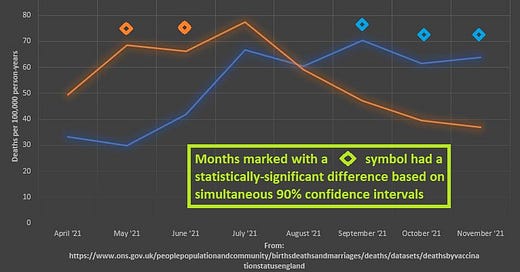In this substack post, it was shown, using UK data from the Office of National Statistics (ONS), that booster shots didn’t lead to a mortality benefit in adults under 40 in England. Even worse, they appeared to have a negative effect by the Fall of 2022.
The data come from England alone and shows deaths and person-years of observation by the month. When those who had been fully jabbed 3 weeks prior were compared to those unjabbed, there were two back-to-back months of significantly higher death among those fully jabbed:
These death rates, reported by month, are annualized (deaths per 100,000 person-years of observation). To check for a significant difference in death rates, simultaneous 90% confidence intervals were formed around the rates, using the Gamma method that the CDC uses.
Evidence suggests that a statistically-significant increase in death was associated with being double-jabbed in May 2021 and in June 2021. This statistically-significant increase in mortality — found to be significant for two months in a row — should have led to pulling the experimental product from the market.
Experimental products demand higher scrutiny, and even one month of statistically-significant increases in death should have gotten them immediately pulled from the market.
Here are the raw data for May 2021 and June 2021 (rates are per 100,000 person-years):
A note to help if you would like to verify the findings above:
Here is example Excel code for obtaining the 90% lower bound death rate for the double-jabbed in May (column P):
=GAMMA.INV(0.05,M4,1)/(N4/100000)
The inverse gamma function here tells you the 5th percentile value when deaths were equal to the number found in cell M4 (66 deaths), and the ending part takes the person-years (N4) and divides by 100,000 to get deaths per 100,000 person-years.
For a sensitivity analysis, simultaneous 95% confidence intervals were still significant, indicating that it had been scientifically knowable — by May 2021 — that these jabs presented a potential threat to human health.
Preemptive response to a criticism
A potential reply from government officials may be that those jabbed were older, therefore leading to higher baseline death.
But this reply is belied by the data from September 2021 going forward — when this supposedly-older group all-of-a-sudden experiences a “fountain-of-youth” effect wherein they die even less than their younger counterparts.
Because COVID itself doesn’t make young people die in great numbers, it is only if the jab had a “magical elixir” effect that it could it ever make old people die less than young people do.
In conclusion, the reply that “those who were jabbed were older!” doesn’t integrate with the death rate experience later on in 2021, and can therefore be dismissed as a viable reason for the significant difference in death rates in May and June of 2021.
A statistically-significant increase in death rates is not something that should be ignored. If government officials fail to report a statistically-significant increase in death rates from a product, then there should be an investigation.
The purpose of medicine is to keep people alive and well, not the opposite.
Reference
[Deaths in England out to December 2022] — ONS. https://www.ons.gov.uk/peoplepopulationandcommunity/birthsdeathsandmarriages/deaths/datasets/deathsbyvaccinationstatusengland





